Business Economics Assignment - Economics of Markets and Policies
VerifiedAdded on 2022/09/08
|37
|10002
|18
Report
AI Summary
This business economics assignment delves into various crucial concepts, beginning with an analysis of monopolized industries and their efficiency. It explores the implications of fixed exchange rate systems and capital controls, as well as the application of the 'Grim Trigger' strategy in promoting collusive behavior. The report then utilizes the AD-IA framework to examine how a closed economy adjusts to changes in government spending. Further discussions include the economic consequences of price floors, the regulation of vertically integrated industries, and the impact of international capital mobility and free trade. The assignment also demonstrates the welfare effects of taxation and subsidies, and it concludes by examining the constraints imposed by fixed exchange rates on macroeconomic policy. Finally, the assignment provides an analysis of the market adjustments and case studies to further understand the dynamics of the market.
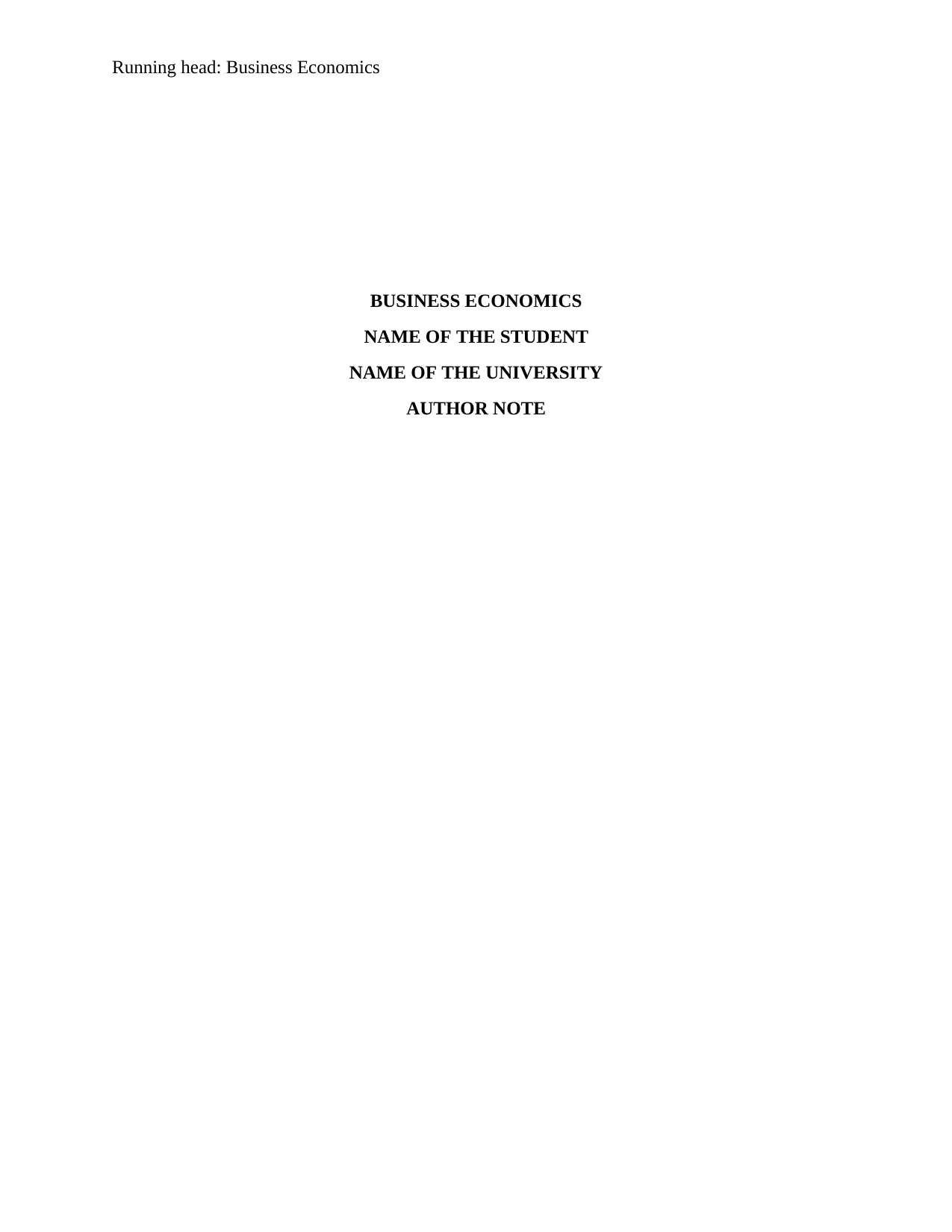
Running head: Business Economics
BUSINESS ECONOMICS
NAME OF THE STUDENT
NAME OF THE UNIVERSITY
AUTHOR NOTE
BUSINESS ECONOMICS
NAME OF THE STUDENT
NAME OF THE UNIVERSITY
AUTHOR NOTE
Paraphrase This Document
Need a fresh take? Get an instant paraphrase of this document with our AI Paraphraser
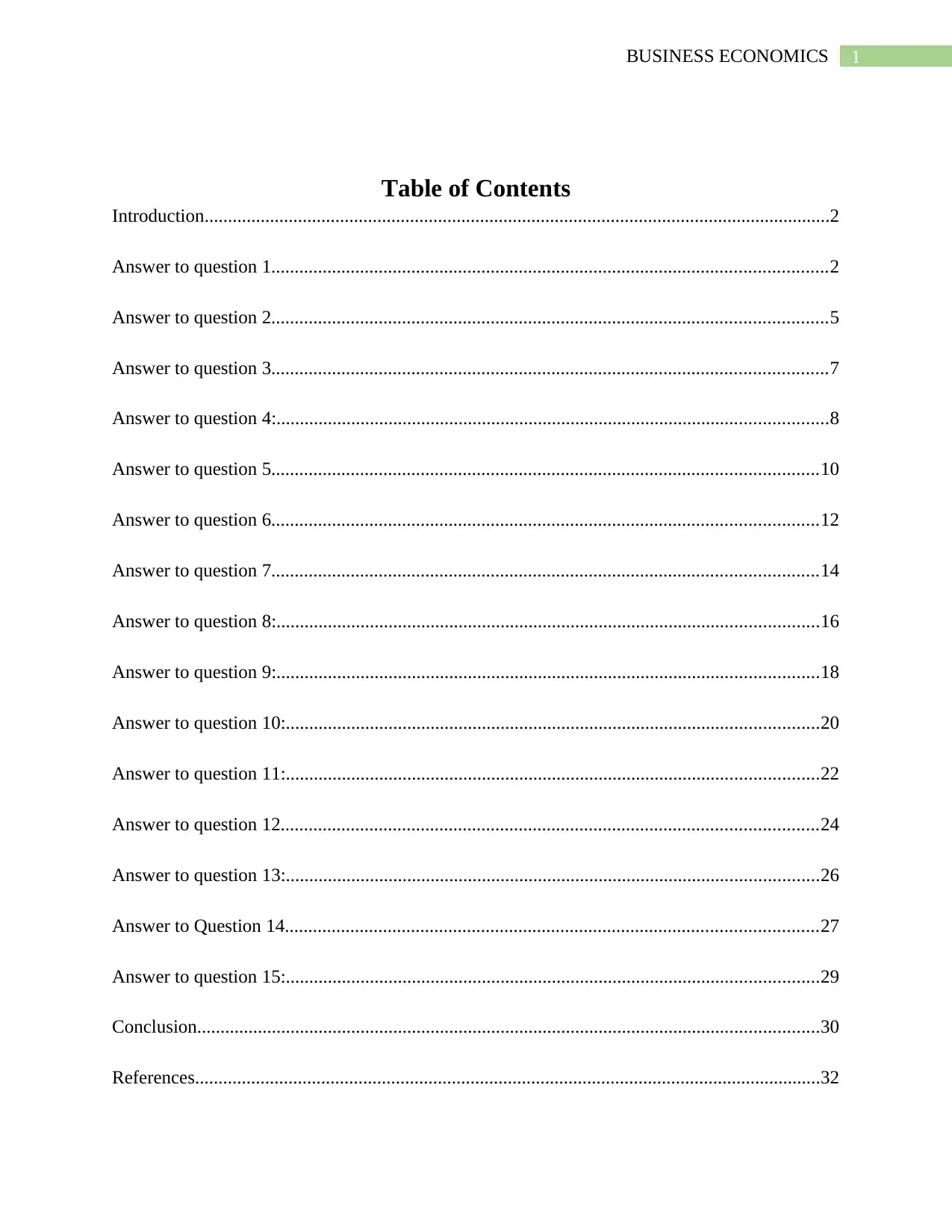
1BUSINESS ECONOMICS
Table of Contents
Introduction......................................................................................................................................2
Answer to question 1.......................................................................................................................2
Answer to question 2.......................................................................................................................5
Answer to question 3.......................................................................................................................7
Answer to question 4:......................................................................................................................8
Answer to question 5.....................................................................................................................10
Answer to question 6.....................................................................................................................12
Answer to question 7.....................................................................................................................14
Answer to question 8:....................................................................................................................16
Answer to question 9:....................................................................................................................18
Answer to question 10:..................................................................................................................20
Answer to question 11:..................................................................................................................22
Answer to question 12...................................................................................................................24
Answer to question 13:..................................................................................................................26
Answer to Question 14..................................................................................................................27
Answer to question 15:..................................................................................................................29
Conclusion.....................................................................................................................................30
References......................................................................................................................................32
Table of Contents
Introduction......................................................................................................................................2
Answer to question 1.......................................................................................................................2
Answer to question 2.......................................................................................................................5
Answer to question 3.......................................................................................................................7
Answer to question 4:......................................................................................................................8
Answer to question 5.....................................................................................................................10
Answer to question 6.....................................................................................................................12
Answer to question 7.....................................................................................................................14
Answer to question 8:....................................................................................................................16
Answer to question 9:....................................................................................................................18
Answer to question 10:..................................................................................................................20
Answer to question 11:..................................................................................................................22
Answer to question 12...................................................................................................................24
Answer to question 13:..................................................................................................................26
Answer to Question 14..................................................................................................................27
Answer to question 15:..................................................................................................................29
Conclusion.....................................................................................................................................30
References......................................................................................................................................32
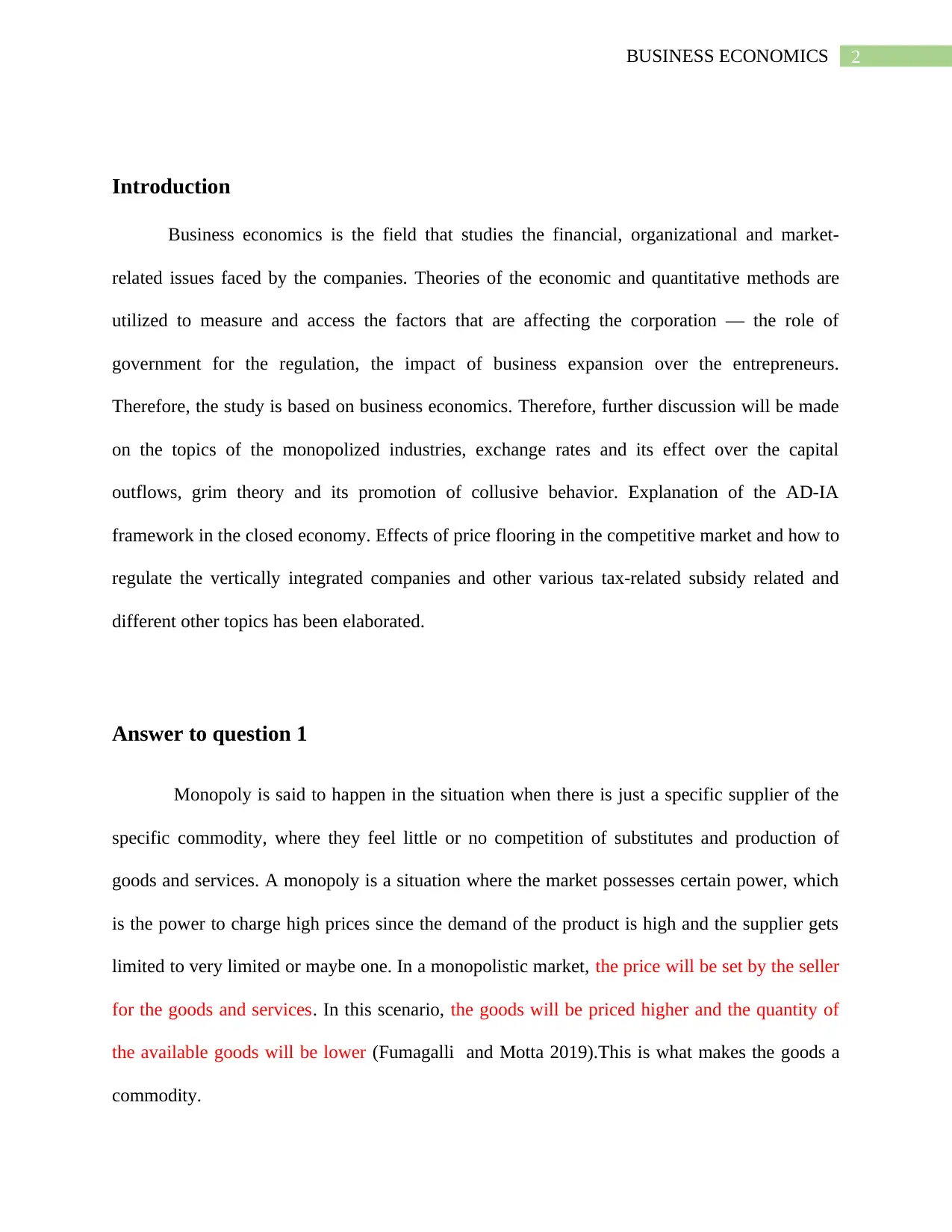
2BUSINESS ECONOMICS
Introduction
Business economics is the field that studies the financial, organizational and market-
related issues faced by the companies. Theories of the economic and quantitative methods are
utilized to measure and access the factors that are affecting the corporation — the role of
government for the regulation, the impact of business expansion over the entrepreneurs.
Therefore, the study is based on business economics. Therefore, further discussion will be made
on the topics of the monopolized industries, exchange rates and its effect over the capital
outflows, grim theory and its promotion of collusive behavior. Explanation of the AD-IA
framework in the closed economy. Effects of price flooring in the competitive market and how to
regulate the vertically integrated companies and other various tax-related subsidy related and
different other topics has been elaborated.
Answer to question 1
Monopoly is said to happen in the situation when there is just a specific supplier of the
specific commodity, where they feel little or no competition of substitutes and production of
goods and services. A monopoly is a situation where the market possesses certain power, which
is the power to charge high prices since the demand of the product is high and the supplier gets
limited to very limited or maybe one. In a monopolistic market, the price will be set by the seller
for the goods and services. In this scenario, the goods will be priced higher and the quantity of
the available goods will be lower (Fumagalli and Motta 2019).This is what makes the goods a
commodity.
Introduction
Business economics is the field that studies the financial, organizational and market-
related issues faced by the companies. Theories of the economic and quantitative methods are
utilized to measure and access the factors that are affecting the corporation — the role of
government for the regulation, the impact of business expansion over the entrepreneurs.
Therefore, the study is based on business economics. Therefore, further discussion will be made
on the topics of the monopolized industries, exchange rates and its effect over the capital
outflows, grim theory and its promotion of collusive behavior. Explanation of the AD-IA
framework in the closed economy. Effects of price flooring in the competitive market and how to
regulate the vertically integrated companies and other various tax-related subsidy related and
different other topics has been elaborated.
Answer to question 1
Monopoly is said to happen in the situation when there is just a specific supplier of the
specific commodity, where they feel little or no competition of substitutes and production of
goods and services. A monopoly is a situation where the market possesses certain power, which
is the power to charge high prices since the demand of the product is high and the supplier gets
limited to very limited or maybe one. In a monopolistic market, the price will be set by the seller
for the goods and services. In this scenario, the goods will be priced higher and the quantity of
the available goods will be lower (Fumagalli and Motta 2019).This is what makes the goods a
commodity.
⊘ This is a preview!⊘
Do you want full access?
Subscribe today to unlock all pages.

Trusted by 1+ million students worldwide
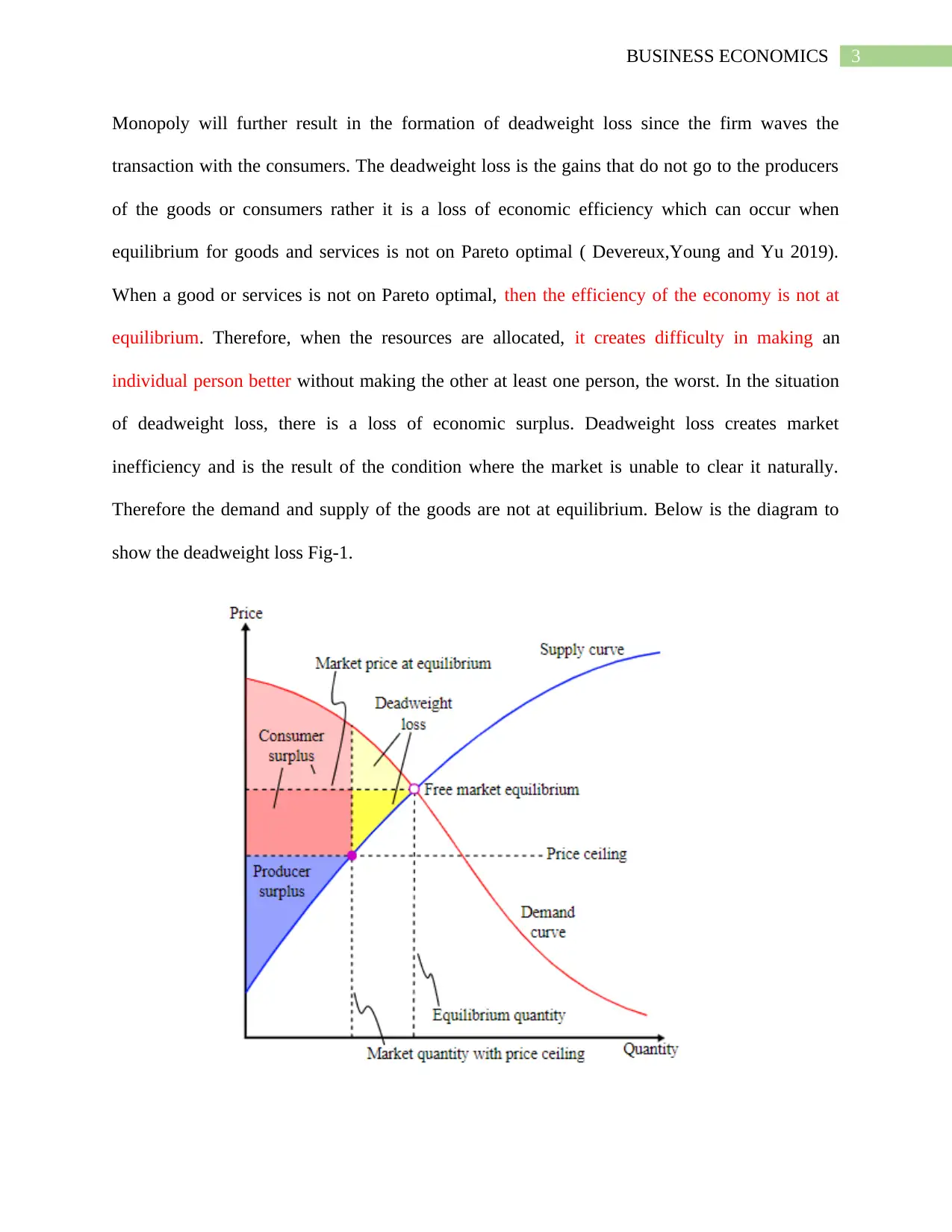
3BUSINESS ECONOMICS
Monopoly will further result in the formation of deadweight loss since the firm waves the
transaction with the consumers. The deadweight loss is the gains that do not go to the producers
of the goods or consumers rather it is a loss of economic efficiency which can occur when
equilibrium for goods and services is not on Pareto optimal ( Devereux,Young and Yu 2019).
When a good or services is not on Pareto optimal, then the efficiency of the economy is not at
equilibrium. Therefore, when the resources are allocated, it creates difficulty in making an
individual person better without making the other at least one person, the worst. In the situation
of deadweight loss, there is a loss of economic surplus. Deadweight loss creates market
inefficiency and is the result of the condition where the market is unable to clear it naturally.
Therefore the demand and supply of the goods are not at equilibrium. Below is the diagram to
show the deadweight loss Fig-1.
Monopoly will further result in the formation of deadweight loss since the firm waves the
transaction with the consumers. The deadweight loss is the gains that do not go to the producers
of the goods or consumers rather it is a loss of economic efficiency which can occur when
equilibrium for goods and services is not on Pareto optimal ( Devereux,Young and Yu 2019).
When a good or services is not on Pareto optimal, then the efficiency of the economy is not at
equilibrium. Therefore, when the resources are allocated, it creates difficulty in making an
individual person better without making the other at least one person, the worst. In the situation
of deadweight loss, there is a loss of economic surplus. Deadweight loss creates market
inefficiency and is the result of the condition where the market is unable to clear it naturally.
Therefore the demand and supply of the goods are not at equilibrium. Below is the diagram to
show the deadweight loss Fig-1.
Paraphrase This Document
Need a fresh take? Get an instant paraphrase of this document with our AI Paraphraser
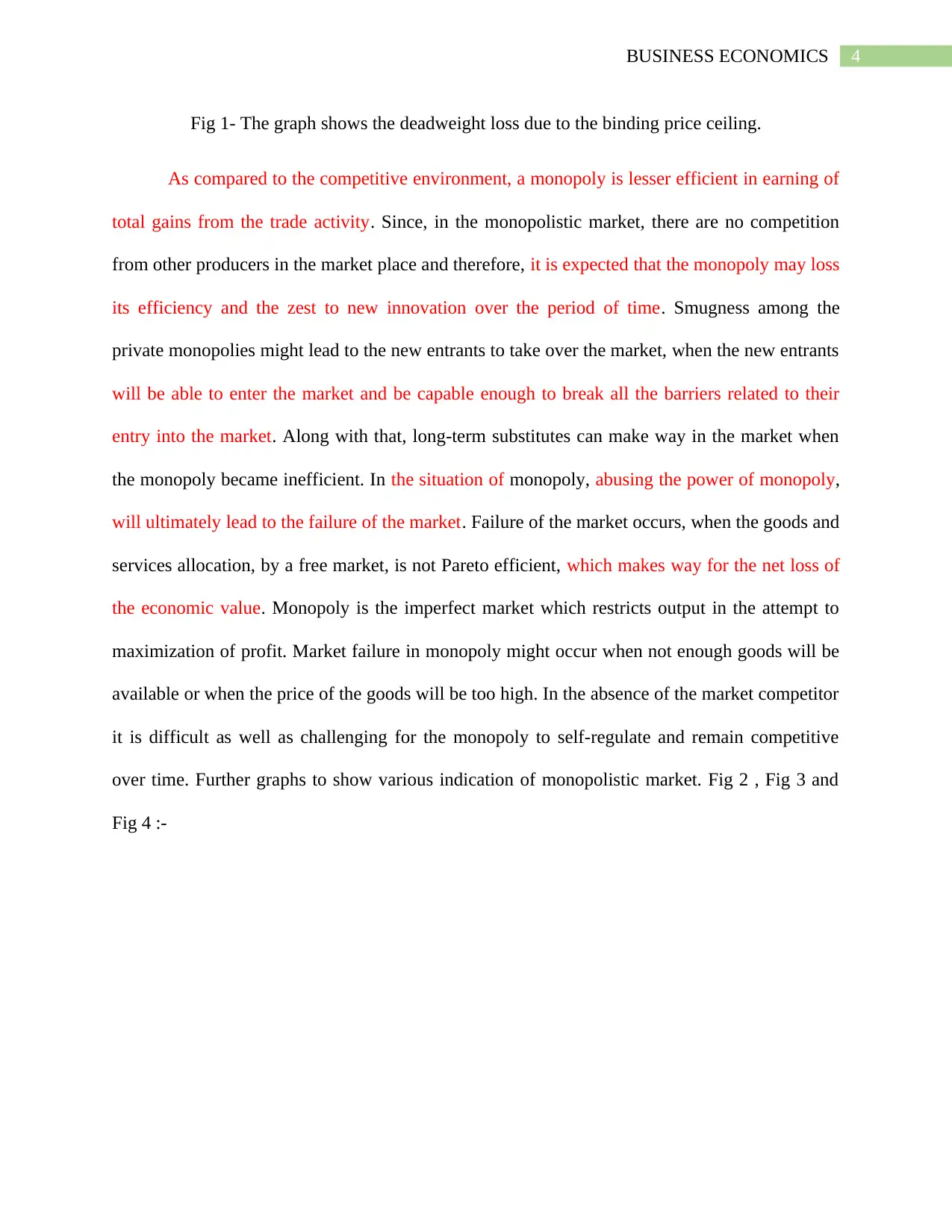
4BUSINESS ECONOMICS
Fig 1- The graph shows the deadweight loss due to the binding price ceiling.
As compared to the competitive environment, a monopoly is lesser efficient in earning of
total gains from the trade activity. Since, in the monopolistic market, there are no competition
from other producers in the market place and therefore, it is expected that the monopoly may loss
its efficiency and the zest to new innovation over the period of time. Smugness among the
private monopolies might lead to the new entrants to take over the market, when the new entrants
will be able to enter the market and be capable enough to break all the barriers related to their
entry into the market. Along with that, long-term substitutes can make way in the market when
the monopoly became inefficient. In the situation of monopoly, abusing the power of monopoly,
will ultimately lead to the failure of the market. Failure of the market occurs, when the goods and
services allocation, by a free market, is not Pareto efficient, which makes way for the net loss of
the economic value. Monopoly is the imperfect market which restricts output in the attempt to
maximization of profit. Market failure in monopoly might occur when not enough goods will be
available or when the price of the goods will be too high. In the absence of the market competitor
it is difficult as well as challenging for the monopoly to self-regulate and remain competitive
over time. Further graphs to show various indication of monopolistic market. Fig 2 , Fig 3 and
Fig 4 :-
Fig 1- The graph shows the deadweight loss due to the binding price ceiling.
As compared to the competitive environment, a monopoly is lesser efficient in earning of
total gains from the trade activity. Since, in the monopolistic market, there are no competition
from other producers in the market place and therefore, it is expected that the monopoly may loss
its efficiency and the zest to new innovation over the period of time. Smugness among the
private monopolies might lead to the new entrants to take over the market, when the new entrants
will be able to enter the market and be capable enough to break all the barriers related to their
entry into the market. Along with that, long-term substitutes can make way in the market when
the monopoly became inefficient. In the situation of monopoly, abusing the power of monopoly,
will ultimately lead to the failure of the market. Failure of the market occurs, when the goods and
services allocation, by a free market, is not Pareto efficient, which makes way for the net loss of
the economic value. Monopoly is the imperfect market which restricts output in the attempt to
maximization of profit. Market failure in monopoly might occur when not enough goods will be
available or when the price of the goods will be too high. In the absence of the market competitor
it is difficult as well as challenging for the monopoly to self-regulate and remain competitive
over time. Further graphs to show various indication of monopolistic market. Fig 2 , Fig 3 and
Fig 4 :-
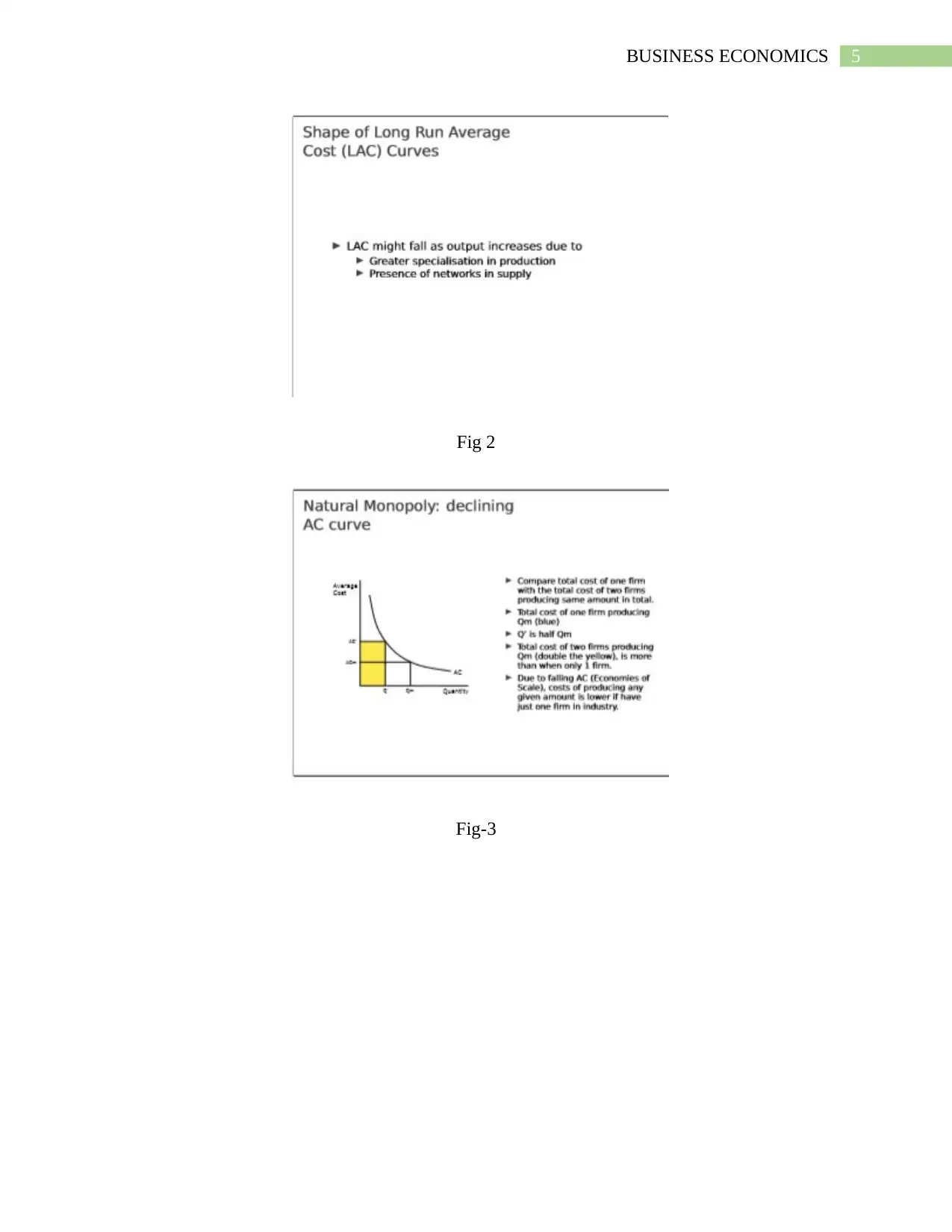
5BUSINESS ECONOMICS
Fig 2
Fig-3
Fig 2
Fig-3
⊘ This is a preview!⊘
Do you want full access?
Subscribe today to unlock all pages.

Trusted by 1+ million students worldwide
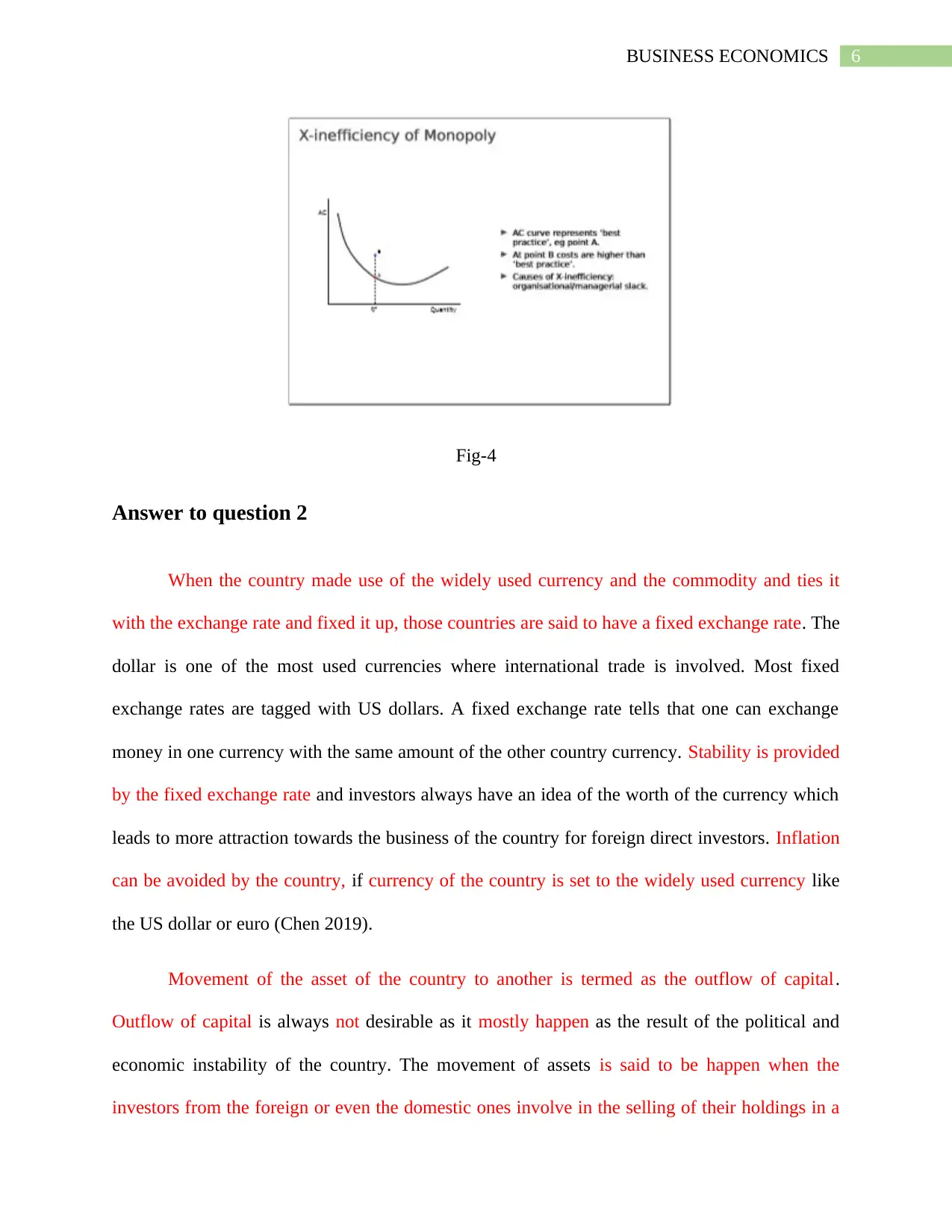
6BUSINESS ECONOMICS
Fig-4
Answer to question 2
When the country made use of the widely used currency and the commodity and ties it
with the exchange rate and fixed it up, those countries are said to have a fixed exchange rate. The
dollar is one of the most used currencies where international trade is involved. Most fixed
exchange rates are tagged with US dollars. A fixed exchange rate tells that one can exchange
money in one currency with the same amount of the other country currency. Stability is provided
by the fixed exchange rate and investors always have an idea of the worth of the currency which
leads to more attraction towards the business of the country for foreign direct investors. Inflation
can be avoided by the country, if currency of the country is set to the widely used currency like
the US dollar or euro (Chen 2019).
Movement of the asset of the country to another is termed as the outflow of capital.
Outflow of capital is always not desirable as it mostly happen as the result of the political and
economic instability of the country. The movement of assets is said to be happen when the
investors from the foreign or even the domestic ones involve in the selling of their holdings in a
Fig-4
Answer to question 2
When the country made use of the widely used currency and the commodity and ties it
with the exchange rate and fixed it up, those countries are said to have a fixed exchange rate. The
dollar is one of the most used currencies where international trade is involved. Most fixed
exchange rates are tagged with US dollars. A fixed exchange rate tells that one can exchange
money in one currency with the same amount of the other country currency. Stability is provided
by the fixed exchange rate and investors always have an idea of the worth of the currency which
leads to more attraction towards the business of the country for foreign direct investors. Inflation
can be avoided by the country, if currency of the country is set to the widely used currency like
the US dollar or euro (Chen 2019).
Movement of the asset of the country to another is termed as the outflow of capital.
Outflow of capital is always not desirable as it mostly happen as the result of the political and
economic instability of the country. The movement of assets is said to be happen when the
investors from the foreign or even the domestic ones involve in the selling of their holdings in a
Paraphrase This Document
Need a fresh take? Get an instant paraphrase of this document with our AI Paraphraser
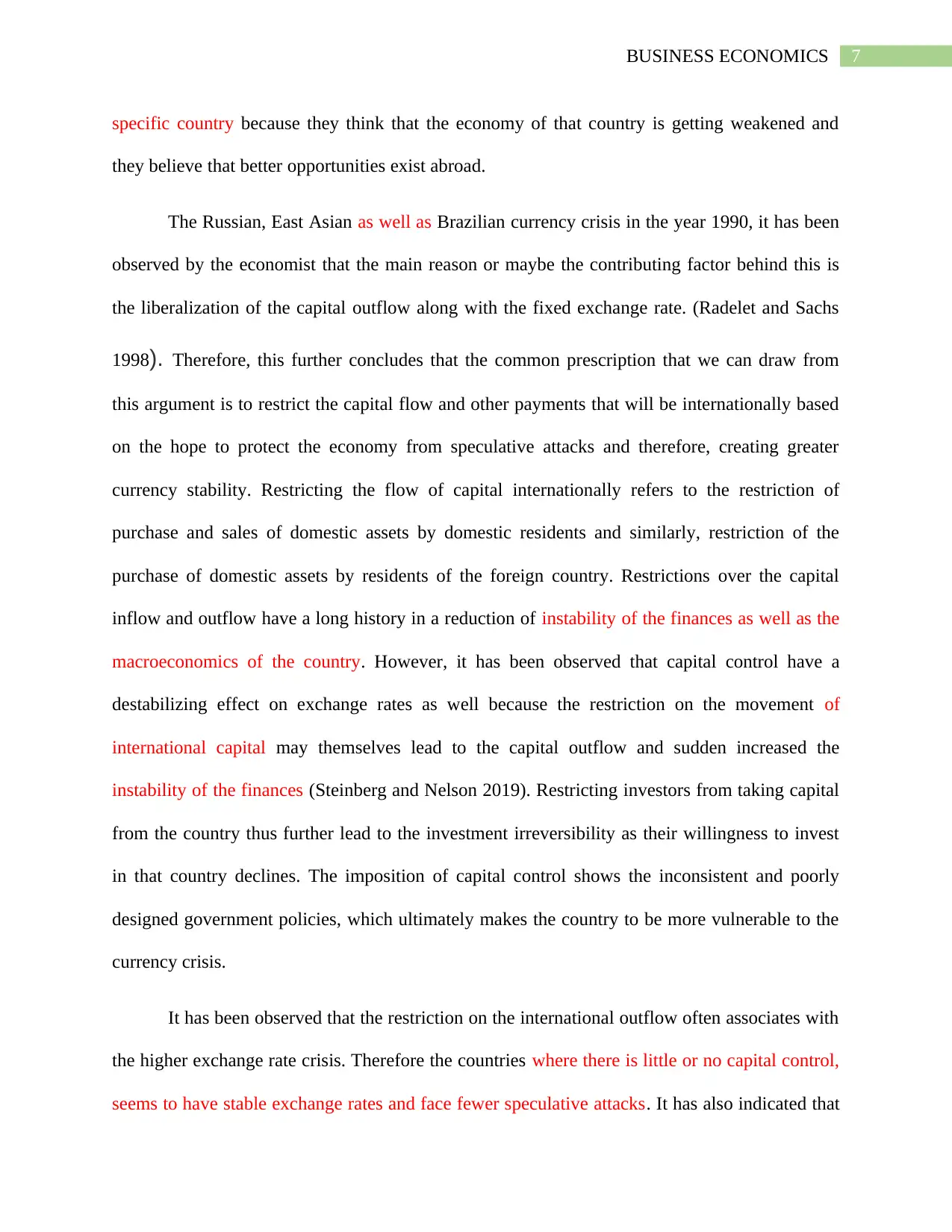
7BUSINESS ECONOMICS
specific country because they think that the economy of that country is getting weakened and
they believe that better opportunities exist abroad.
The Russian, East Asian as well as Brazilian currency crisis in the year 1990, it has been
observed by the economist that the main reason or maybe the contributing factor behind this is
the liberalization of the capital outflow along with the fixed exchange rate. (Radelet and Sachs
1998). Therefore, this further concludes that the common prescription that we can draw from
this argument is to restrict the capital flow and other payments that will be internationally based
on the hope to protect the economy from speculative attacks and therefore, creating greater
currency stability. Restricting the flow of capital internationally refers to the restriction of
purchase and sales of domestic assets by domestic residents and similarly, restriction of the
purchase of domestic assets by residents of the foreign country. Restrictions over the capital
inflow and outflow have a long history in a reduction of instability of the finances as well as the
macroeconomics of the country. However, it has been observed that capital control have a
destabilizing effect on exchange rates as well because the restriction on the movement of
international capital may themselves lead to the capital outflow and sudden increased the
instability of the finances (Steinberg and Nelson 2019). Restricting investors from taking capital
from the country thus further lead to the investment irreversibility as their willingness to invest
in that country declines. The imposition of capital control shows the inconsistent and poorly
designed government policies, which ultimately makes the country to be more vulnerable to the
currency crisis.
It has been observed that the restriction on the international outflow often associates with
the higher exchange rate crisis. Therefore the countries where there is little or no capital control,
seems to have stable exchange rates and face fewer speculative attacks. It has also indicated that
specific country because they think that the economy of that country is getting weakened and
they believe that better opportunities exist abroad.
The Russian, East Asian as well as Brazilian currency crisis in the year 1990, it has been
observed by the economist that the main reason or maybe the contributing factor behind this is
the liberalization of the capital outflow along with the fixed exchange rate. (Radelet and Sachs
1998). Therefore, this further concludes that the common prescription that we can draw from
this argument is to restrict the capital flow and other payments that will be internationally based
on the hope to protect the economy from speculative attacks and therefore, creating greater
currency stability. Restricting the flow of capital internationally refers to the restriction of
purchase and sales of domestic assets by domestic residents and similarly, restriction of the
purchase of domestic assets by residents of the foreign country. Restrictions over the capital
inflow and outflow have a long history in a reduction of instability of the finances as well as the
macroeconomics of the country. However, it has been observed that capital control have a
destabilizing effect on exchange rates as well because the restriction on the movement of
international capital may themselves lead to the capital outflow and sudden increased the
instability of the finances (Steinberg and Nelson 2019). Restricting investors from taking capital
from the country thus further lead to the investment irreversibility as their willingness to invest
in that country declines. The imposition of capital control shows the inconsistent and poorly
designed government policies, which ultimately makes the country to be more vulnerable to the
currency crisis.
It has been observed that the restriction on the international outflow often associates with
the higher exchange rate crisis. Therefore the countries where there is little or no capital control,
seems to have stable exchange rates and face fewer speculative attacks. It has also indicated that
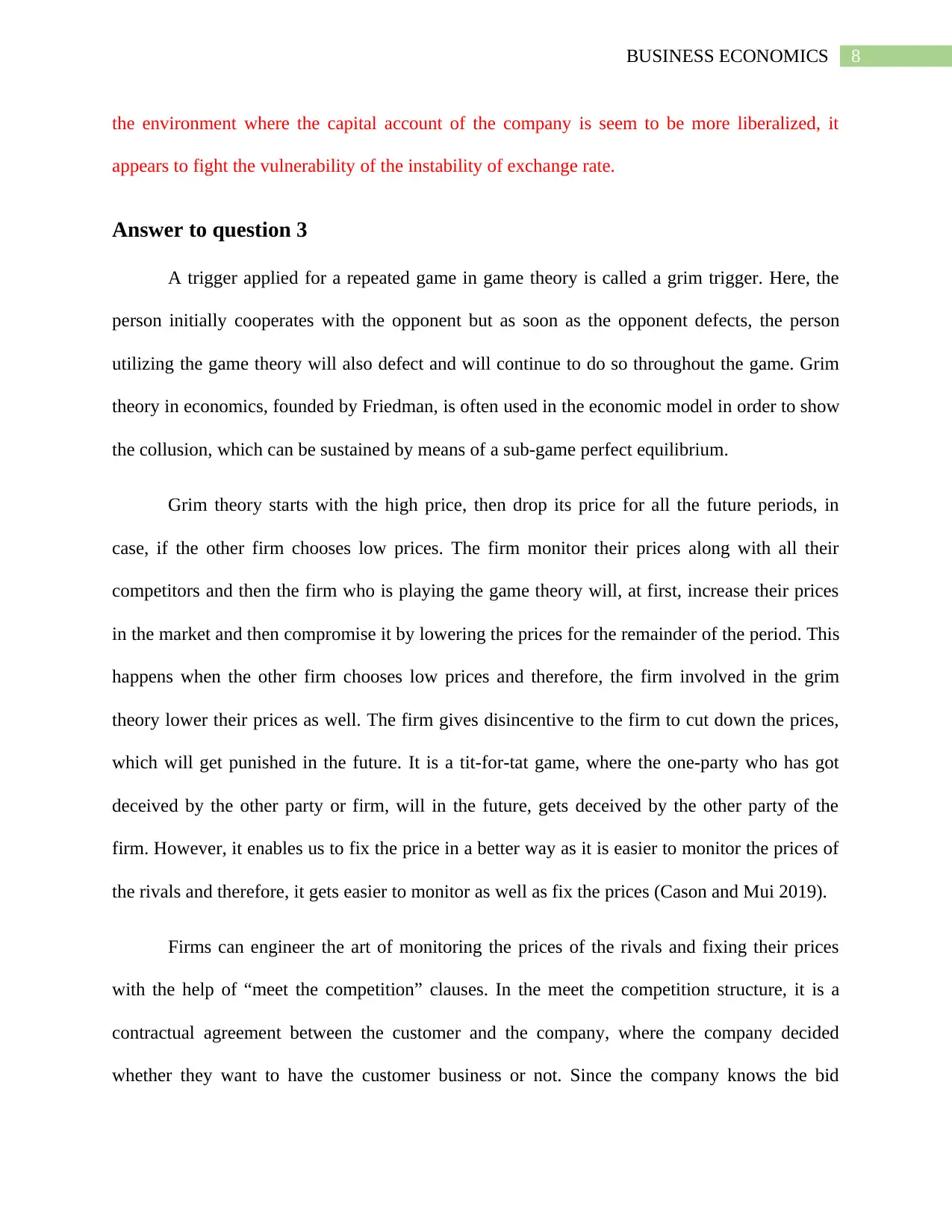
8BUSINESS ECONOMICS
the environment where the capital account of the company is seem to be more liberalized, it
appears to fight the vulnerability of the instability of exchange rate.
Answer to question 3
A trigger applied for a repeated game in game theory is called a grim trigger. Here, the
person initially cooperates with the opponent but as soon as the opponent defects, the person
utilizing the game theory will also defect and will continue to do so throughout the game. Grim
theory in economics, founded by Friedman, is often used in the economic model in order to show
the collusion, which can be sustained by means of a sub-game perfect equilibrium.
Grim theory starts with the high price, then drop its price for all the future periods, in
case, if the other firm chooses low prices. The firm monitor their prices along with all their
competitors and then the firm who is playing the game theory will, at first, increase their prices
in the market and then compromise it by lowering the prices for the remainder of the period. This
happens when the other firm chooses low prices and therefore, the firm involved in the grim
theory lower their prices as well. The firm gives disincentive to the firm to cut down the prices,
which will get punished in the future. It is a tit-for-tat game, where the one-party who has got
deceived by the other party or firm, will in the future, gets deceived by the other party of the
firm. However, it enables us to fix the price in a better way as it is easier to monitor the prices of
the rivals and therefore, it gets easier to monitor as well as fix the prices (Cason and Mui 2019).
Firms can engineer the art of monitoring the prices of the rivals and fixing their prices
with the help of “meet the competition” clauses. In the meet the competition structure, it is a
contractual agreement between the customer and the company, where the company decided
whether they want to have the customer business or not. Since the company knows the bid
the environment where the capital account of the company is seem to be more liberalized, it
appears to fight the vulnerability of the instability of exchange rate.
Answer to question 3
A trigger applied for a repeated game in game theory is called a grim trigger. Here, the
person initially cooperates with the opponent but as soon as the opponent defects, the person
utilizing the game theory will also defect and will continue to do so throughout the game. Grim
theory in economics, founded by Friedman, is often used in the economic model in order to show
the collusion, which can be sustained by means of a sub-game perfect equilibrium.
Grim theory starts with the high price, then drop its price for all the future periods, in
case, if the other firm chooses low prices. The firm monitor their prices along with all their
competitors and then the firm who is playing the game theory will, at first, increase their prices
in the market and then compromise it by lowering the prices for the remainder of the period. This
happens when the other firm chooses low prices and therefore, the firm involved in the grim
theory lower their prices as well. The firm gives disincentive to the firm to cut down the prices,
which will get punished in the future. It is a tit-for-tat game, where the one-party who has got
deceived by the other party or firm, will in the future, gets deceived by the other party of the
firm. However, it enables us to fix the price in a better way as it is easier to monitor the prices of
the rivals and therefore, it gets easier to monitor as well as fix the prices (Cason and Mui 2019).
Firms can engineer the art of monitoring the prices of the rivals and fixing their prices
with the help of “meet the competition” clauses. In the meet the competition structure, it is a
contractual agreement between the customer and the company, where the company decided
whether they want to have the customer business or not. Since the company knows the bid
⊘ This is a preview!⊘
Do you want full access?
Subscribe today to unlock all pages.

Trusted by 1+ million students worldwide
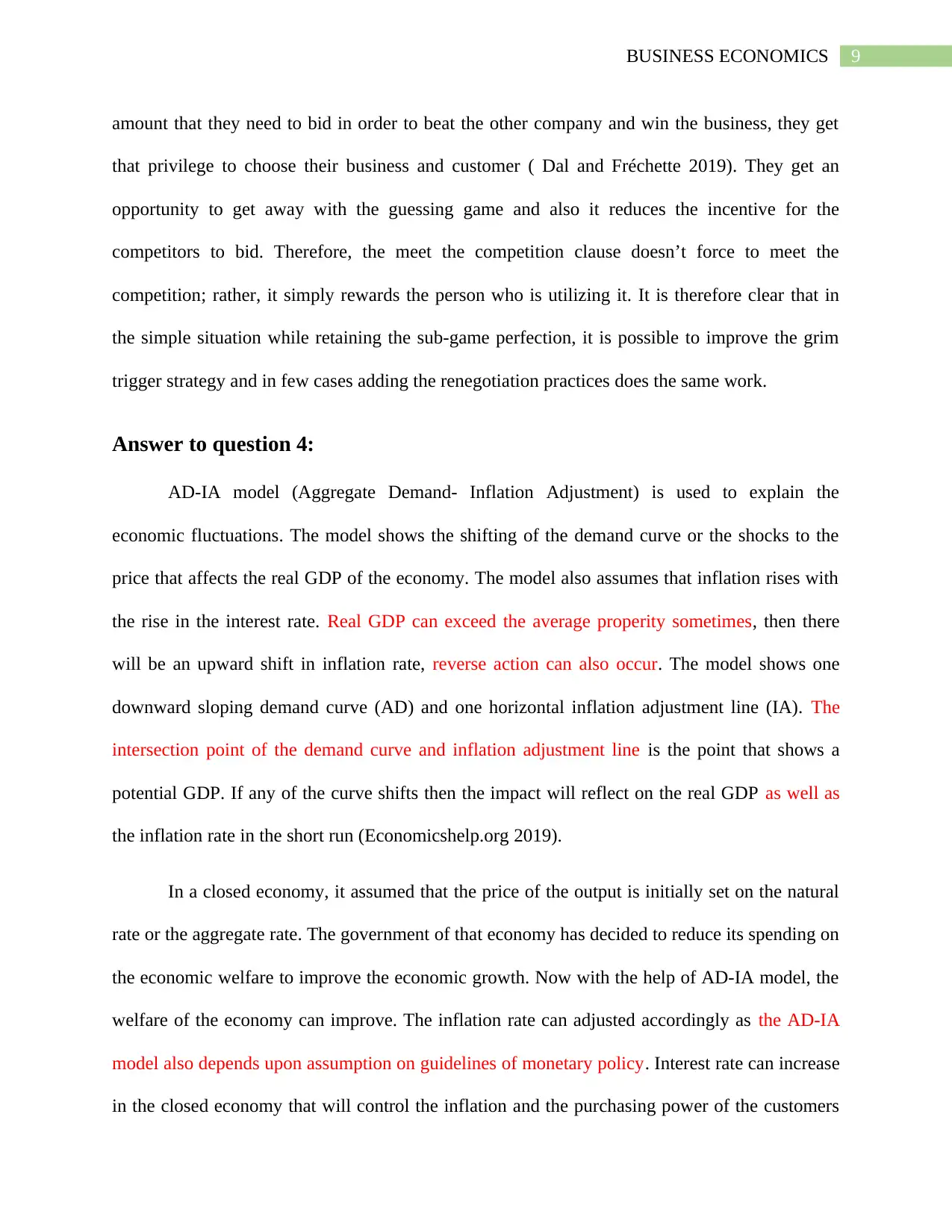
9BUSINESS ECONOMICS
amount that they need to bid in order to beat the other company and win the business, they get
that privilege to choose their business and customer ( Dal and Fréchette 2019). They get an
opportunity to get away with the guessing game and also it reduces the incentive for the
competitors to bid. Therefore, the meet the competition clause doesn’t force to meet the
competition; rather, it simply rewards the person who is utilizing it. It is therefore clear that in
the simple situation while retaining the sub-game perfection, it is possible to improve the grim
trigger strategy and in few cases adding the renegotiation practices does the same work.
Answer to question 4:
AD-IA model (Aggregate Demand- Inflation Adjustment) is used to explain the
economic fluctuations. The model shows the shifting of the demand curve or the shocks to the
price that affects the real GDP of the economy. The model also assumes that inflation rises with
the rise in the interest rate. Real GDP can exceed the average properity sometimes, then there
will be an upward shift in inflation rate, reverse action can also occur. The model shows one
downward sloping demand curve (AD) and one horizontal inflation adjustment line (IA). The
intersection point of the demand curve and inflation adjustment line is the point that shows a
potential GDP. If any of the curve shifts then the impact will reflect on the real GDP as well as
the inflation rate in the short run (Economicshelp.org 2019).
In a closed economy, it assumed that the price of the output is initially set on the natural
rate or the aggregate rate. The government of that economy has decided to reduce its spending on
the economic welfare to improve the economic growth. Now with the help of AD-IA model, the
welfare of the economy can improve. The inflation rate can adjusted accordingly as the AD-IA
model also depends upon assumption on guidelines of monetary policy. Interest rate can increase
in the closed economy that will control the inflation and the purchasing power of the customers
amount that they need to bid in order to beat the other company and win the business, they get
that privilege to choose their business and customer ( Dal and Fréchette 2019). They get an
opportunity to get away with the guessing game and also it reduces the incentive for the
competitors to bid. Therefore, the meet the competition clause doesn’t force to meet the
competition; rather, it simply rewards the person who is utilizing it. It is therefore clear that in
the simple situation while retaining the sub-game perfection, it is possible to improve the grim
trigger strategy and in few cases adding the renegotiation practices does the same work.
Answer to question 4:
AD-IA model (Aggregate Demand- Inflation Adjustment) is used to explain the
economic fluctuations. The model shows the shifting of the demand curve or the shocks to the
price that affects the real GDP of the economy. The model also assumes that inflation rises with
the rise in the interest rate. Real GDP can exceed the average properity sometimes, then there
will be an upward shift in inflation rate, reverse action can also occur. The model shows one
downward sloping demand curve (AD) and one horizontal inflation adjustment line (IA). The
intersection point of the demand curve and inflation adjustment line is the point that shows a
potential GDP. If any of the curve shifts then the impact will reflect on the real GDP as well as
the inflation rate in the short run (Economicshelp.org 2019).
In a closed economy, it assumed that the price of the output is initially set on the natural
rate or the aggregate rate. The government of that economy has decided to reduce its spending on
the economic welfare to improve the economic growth. Now with the help of AD-IA model, the
welfare of the economy can improve. The inflation rate can adjusted accordingly as the AD-IA
model also depends upon assumption on guidelines of monetary policy. Interest rate can increase
in the closed economy that will control the inflation and the purchasing power of the customers
Paraphrase This Document
Need a fresh take? Get an instant paraphrase of this document with our AI Paraphraser
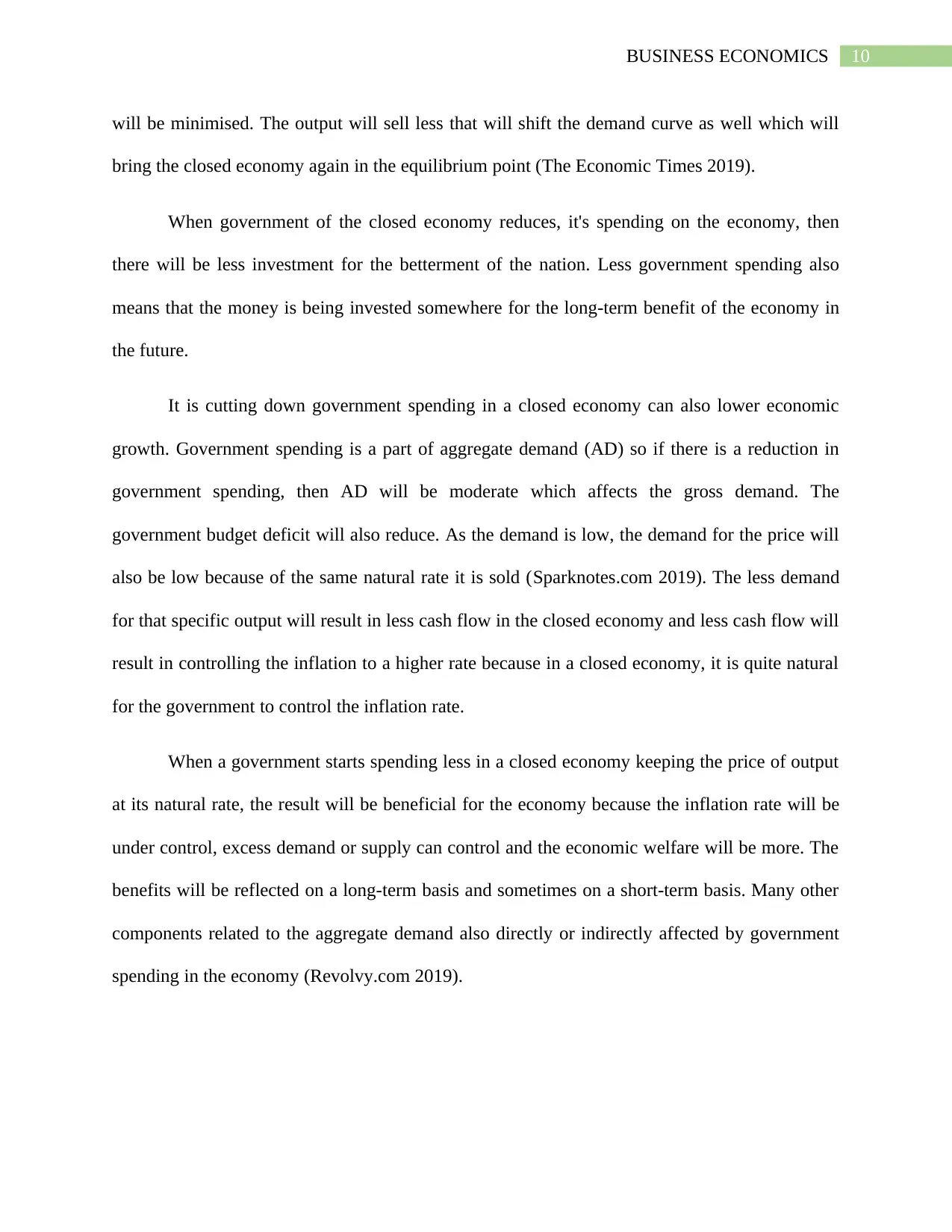
10BUSINESS ECONOMICS
will be minimised. The output will sell less that will shift the demand curve as well which will
bring the closed economy again in the equilibrium point (The Economic Times 2019).
When government of the closed economy reduces, it's spending on the economy, then
there will be less investment for the betterment of the nation. Less government spending also
means that the money is being invested somewhere for the long-term benefit of the economy in
the future.
It is cutting down government spending in a closed economy can also lower economic
growth. Government spending is a part of aggregate demand (AD) so if there is a reduction in
government spending, then AD will be moderate which affects the gross demand. The
government budget deficit will also reduce. As the demand is low, the demand for the price will
also be low because of the same natural rate it is sold (Sparknotes.com 2019). The less demand
for that specific output will result in less cash flow in the closed economy and less cash flow will
result in controlling the inflation to a higher rate because in a closed economy, it is quite natural
for the government to control the inflation rate.
When a government starts spending less in a closed economy keeping the price of output
at its natural rate, the result will be beneficial for the economy because the inflation rate will be
under control, excess demand or supply can control and the economic welfare will be more. The
benefits will be reflected on a long-term basis and sometimes on a short-term basis. Many other
components related to the aggregate demand also directly or indirectly affected by government
spending in the economy (Revolvy.com 2019).
will be minimised. The output will sell less that will shift the demand curve as well which will
bring the closed economy again in the equilibrium point (The Economic Times 2019).
When government of the closed economy reduces, it's spending on the economy, then
there will be less investment for the betterment of the nation. Less government spending also
means that the money is being invested somewhere for the long-term benefit of the economy in
the future.
It is cutting down government spending in a closed economy can also lower economic
growth. Government spending is a part of aggregate demand (AD) so if there is a reduction in
government spending, then AD will be moderate which affects the gross demand. The
government budget deficit will also reduce. As the demand is low, the demand for the price will
also be low because of the same natural rate it is sold (Sparknotes.com 2019). The less demand
for that specific output will result in less cash flow in the closed economy and less cash flow will
result in controlling the inflation to a higher rate because in a closed economy, it is quite natural
for the government to control the inflation rate.
When a government starts spending less in a closed economy keeping the price of output
at its natural rate, the result will be beneficial for the economy because the inflation rate will be
under control, excess demand or supply can control and the economic welfare will be more. The
benefits will be reflected on a long-term basis and sometimes on a short-term basis. Many other
components related to the aggregate demand also directly or indirectly affected by government
spending in the economy (Revolvy.com 2019).
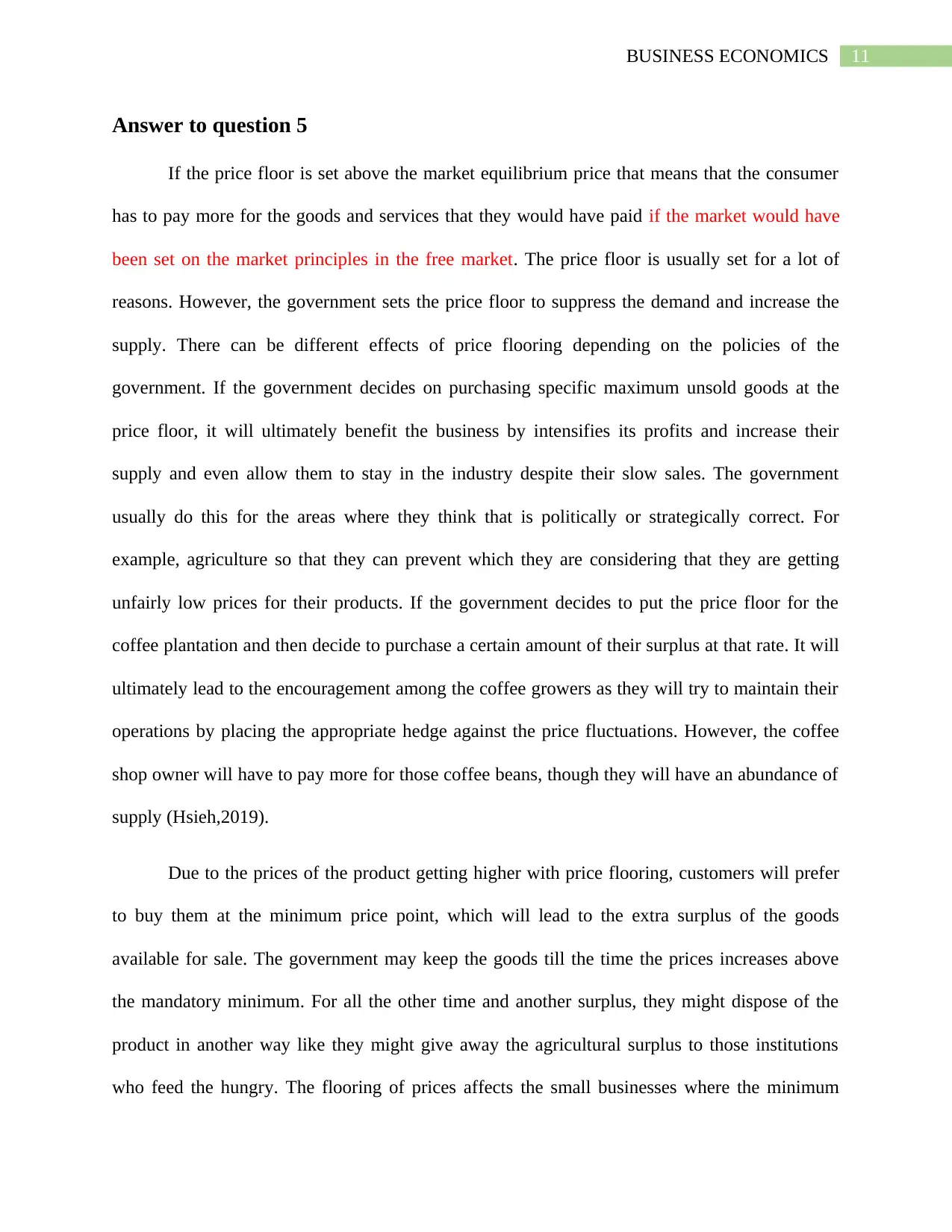
11BUSINESS ECONOMICS
Answer to question 5
If the price floor is set above the market equilibrium price that means that the consumer
has to pay more for the goods and services that they would have paid if the market would have
been set on the market principles in the free market. The price floor is usually set for a lot of
reasons. However, the government sets the price floor to suppress the demand and increase the
supply. There can be different effects of price flooring depending on the policies of the
government. If the government decides on purchasing specific maximum unsold goods at the
price floor, it will ultimately benefit the business by intensifies its profits and increase their
supply and even allow them to stay in the industry despite their slow sales. The government
usually do this for the areas where they think that is politically or strategically correct. For
example, agriculture so that they can prevent which they are considering that they are getting
unfairly low prices for their products. If the government decides to put the price floor for the
coffee plantation and then decide to purchase a certain amount of their surplus at that rate. It will
ultimately lead to the encouragement among the coffee growers as they will try to maintain their
operations by placing the appropriate hedge against the price fluctuations. However, the coffee
shop owner will have to pay more for those coffee beans, though they will have an abundance of
supply (Hsieh,2019).
Due to the prices of the product getting higher with price flooring, customers will prefer
to buy them at the minimum price point, which will lead to the extra surplus of the goods
available for sale. The government may keep the goods till the time the prices increases above
the mandatory minimum. For all the other time and another surplus, they might dispose of the
product in another way like they might give away the agricultural surplus to those institutions
who feed the hungry. The flooring of prices affects the small businesses where the minimum
Answer to question 5
If the price floor is set above the market equilibrium price that means that the consumer
has to pay more for the goods and services that they would have paid if the market would have
been set on the market principles in the free market. The price floor is usually set for a lot of
reasons. However, the government sets the price floor to suppress the demand and increase the
supply. There can be different effects of price flooring depending on the policies of the
government. If the government decides on purchasing specific maximum unsold goods at the
price floor, it will ultimately benefit the business by intensifies its profits and increase their
supply and even allow them to stay in the industry despite their slow sales. The government
usually do this for the areas where they think that is politically or strategically correct. For
example, agriculture so that they can prevent which they are considering that they are getting
unfairly low prices for their products. If the government decides to put the price floor for the
coffee plantation and then decide to purchase a certain amount of their surplus at that rate. It will
ultimately lead to the encouragement among the coffee growers as they will try to maintain their
operations by placing the appropriate hedge against the price fluctuations. However, the coffee
shop owner will have to pay more for those coffee beans, though they will have an abundance of
supply (Hsieh,2019).
Due to the prices of the product getting higher with price flooring, customers will prefer
to buy them at the minimum price point, which will lead to the extra surplus of the goods
available for sale. The government may keep the goods till the time the prices increases above
the mandatory minimum. For all the other time and another surplus, they might dispose of the
product in another way like they might give away the agricultural surplus to those institutions
who feed the hungry. The flooring of prices affects the small businesses where the minimum
⊘ This is a preview!⊘
Do you want full access?
Subscribe today to unlock all pages.

Trusted by 1+ million students worldwide
1 out of 37
Related Documents
Your All-in-One AI-Powered Toolkit for Academic Success.
+13062052269
info@desklib.com
Available 24*7 on WhatsApp / Email
![[object Object]](/_next/static/media/star-bottom.7253800d.svg)
Unlock your academic potential
Copyright © 2020–2025 A2Z Services. All Rights Reserved. Developed and managed by ZUCOL.





